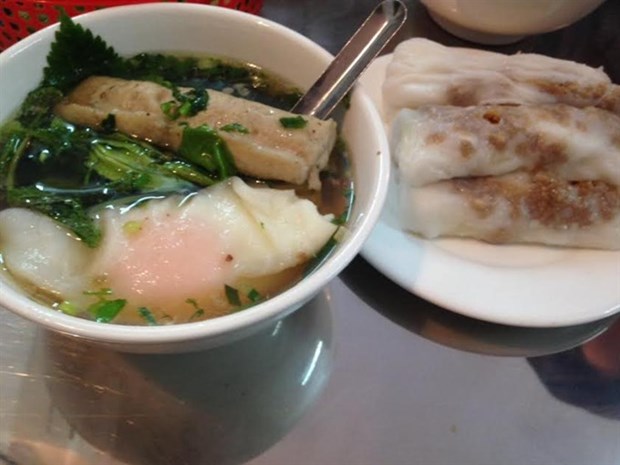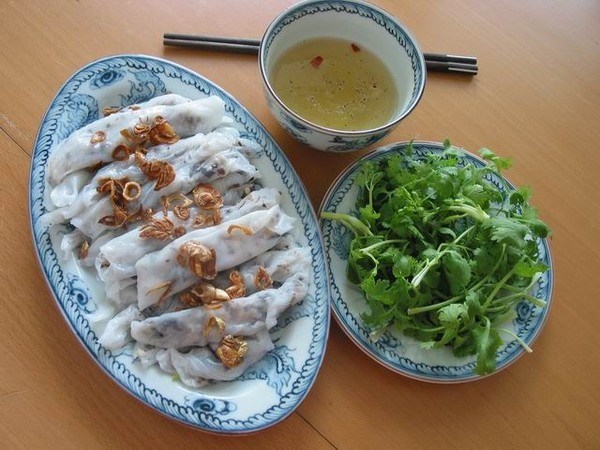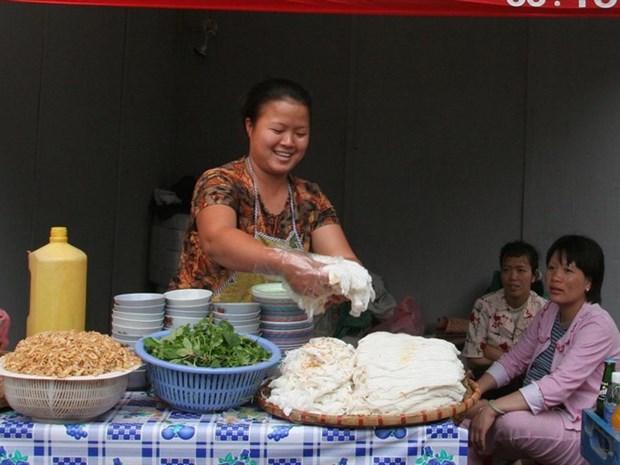With a history stretching back thousands of years, bánh cuốn (rolled cake) still proves to be a popular choice for diners in Việt Nam, and has even inspired some of the country’s renowned writers.

Hearty broth: In the northern provinces of Cao Bằng and Lạng Sơn, rolled cake is eaten with pork bone broth, instead of fish sauce like in Hà Nội. —Photo baocaobang.vn
Among
the well-known offerings of Hà Nội street food, bánh cuốn is consistently ranked a top choice.
Vũ
Bằng, a writer known for his beautiful prose on ancient Hà Nội, once wrote that
“a visitor from Hải Phòng, Nam Định or Thanh Nghệ, for example, that comes to
Hà Nội and has the chance to eat bánh cuốn served with hot fried tofu will never forget
this special dish.”
Bánh cuốn was born in Thanh Trì, an ancient
suburb of Hà Nội, and bánh cuốn of
Thanh Trì is still said to be the best.
Bằng
wrote that he had been to several rural markets, and tried all types of rolled
cake, but often the thick rice paper or strong smell of rice flour he found
fell short of the bánh cuốn of Thanh
Trì, and enhanced his longing for Hà Nội
When
thinking of rolled cake, the Vietnamese may conjure images of Thanh Trì rolled
cake, which is thin like paper and looks almost transparent. Taking a piece of
rolled cake – the thin Thanh Trì rice paper rolled with a few wood ear
mushrooms and some spring onions fried in oil and dipped in fish sauce – is a
delight for the senses. Bánh cuốn is
often served with fried tofu or chả (Vietnamese sausage).
When
he was away from Hà Nội during wartime, the young Vũ Bằng missed his hometown
and its food, especially the bánh cuốn.
He
wrote “Once one has tasted the rolled cake, he would remember it for the rest
of his life. He would miss everything about it – from the dipping sauce, and
the texture to the graceful posture of the rolled cake vendor.”
In
times gone by, the rolled cakes would be seen piled high in vendors’ baskets.
The rolled cake vendors, with their baskets full of delicacies were described
as “having graceful and agile postures” by writer Thạch Lam. The women
travelled around the city selling the rolled cake.
Nowadays,
diners in Hà Nội can find old eateries serving Thanh Trì rolled cake, like
Thanh Vân Rolled Cake or Mrs Hoành Rolled Cake, just to name a few.
Today’s
rolled cake sellers are still ‘graceful’ and ‘agile’ in the way Thạch Lam
described – when customers order, they prepare rice flour, spread a spoonful of
wet batter over the closely woven steaming basket and then take out the
almost-transparent rice sheet with a bamboo stick.
Minced
pork and wood ear mushrooms are then rolled in the rice sheet, ready to be
served with dipping sauce. The sauce served with the rolled cake is similar to
that in bún chả (noodles served with grilled pork) – fish sauce with sugar,
water (to lessen the saltiness), chili and vinegar.
Traditionally,
cà cuống was added to the dipping
sauce (cà cuống is a fragrant oil
made from an insect). However, today it is hard to find such an addition.
Other
localities including Cao Bằng and Lào Cai developed their own version of the
rolled cake, with their own unique take on the dish.
In
the northern provinces of Cao Bằng and Lạng Sơn, rolled cake is eaten with pork
bone broth, instead of fish sauce like in Hà Nội. While spreading wet batter
over the steaming basket, cooks would add an egg, and then cover the cooked egg
with a rice sheet. Diners could add some fermented bamboo shoots and chili to
fortify their broth.

Ancient techniques: Taking a piece of rolled cake – the thin Thanh Trì rice paper rolled with a few wood ear mushrooms and some spring onions fried in oil and dipped in fish sauce – is a delight for the senses. — Photo giadinh.net.vn

Delicious dish: A seller prepares rolled cakes for customers. Nowadays, diners in Hà Nội can find the dish at old eateries like Thanh Vân Rolled Cake (14 Hàng Gà)and Mrs Hoành Rolled Cake in 66 Tô Hiến Thành. — VNS Photo Trương Vị
Bánh cuốn can be
found at:
Hà
Nội:
66
Tô Hiến Thành Street.
14
Hàng Gà Street.
101
Bà Triệu Street.
61
Huỳnh Thúc Kháng Street.
HCM
City:
11A
Cao Thắng Street.
17A
Nguyễn Thị Minh Khai Street.
353
Lê Văn Sỹ Street.
By Hồng Vân/ Viet Nam News